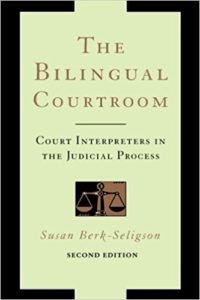22 Jan Book Review: The Bilingual Courtroom – Court Interpreters in the Judicial Process

The Bilingual Courtroom – Court Interpreters in the Judicial Process, 2nd Edition
Author: Susan Berk-Seligson
Publisher: The University of Chicago Press, 2017
Pages: 363
By Gladys Matthews, Ph.D.
Susan Berk-Seligson’s The Bilingual Courtroom. Court Interpreters in the Judicial Process is a comprehensive empirical study of the use of interpreters in court settings in the United States and one of the most important works in the field. The first edition dates from 1990, and in 2002 a new edition was published, but curiously it was not referenced as the second edition (instead, the cover contained the tag “With a New Chapter”). Consequently, while the 2017 edition is listed as the second edition, it is in fact the third one.
This new edition reflects the extensive additions to the literature in the field of court interpreting in the past 15 years, including NAJIT’s Code of Ethics and Professional Responsibilities. As the author says, the new references highlight the recognition given to this field of inquiry. The new edition also discusses the geopolitical events that increased the need for skilled interpreters in languages other than Spanish, including the war on terrorism in the wake of the 9/11 attacks and, more recently, the immigration crisis involving thousands from the Middle East fleeing war and seeking asylum. It also discusses the growing need for qualified interpreters in languages of lesser diffusion, including indigenous languages. In some cases, relay interpreting is needed due to a shortage of interpreters who can interpret these languages directly into English.
In this edition, the author shows how the presence of an interpreter transforms court proceedings into what she calls a bilingual event; as suggested by the subject and title of the book: The Bilingual Courtroom. To understand the bilingual courtroom, she draws on seven months of ethnographic observations and 114 hours of recordings of interpreted proceedings from federal, state, and municipal courts.

The Bilingual Courtroom contains ten chapters and seven appendices. Chapter 1 gives an overview of the role of the interpreter in legal settings, Chapter 2 discusses the complex characteristics of legal language, and Chapter 3 reviews the legislation, court opinions, and executive orders that guarantee the right to an interpreter. Chapter 4 describes the methodology used in the study, including the collection of thousands of hours of recorded court proceedings and transcription of the 114 hours selected for analysis. Researchers and others will be interested in her discussion of the challenges that obtaining permission from all parties involved (attorneys, judges, defendants, etc.) entailed. These transcriptions are used in Chapter 5 to illustrate the way the interpreter sees her role and is seen by other participants in the courtroom, as illustrated by such events as departures from court protocol by judges and attorneys who address the interpreter rather than the witness or defendant and attempts by the interpreter to clarify the utterances of various parties, including attorneys’ questions, witness’s answers, etc.
Chapter 6 and 7 draw from the data and evidence to show the range of ways interpreters use language to affect what happens in the courtroom, including use of the passive and active voice and other pragmatic elements that have subtle – or not so subtle – effects on the rendition. As one example, the consequences of interpreter approach to pragmatic elements may include making the tone of the attorney or witness harsher than intended or, conversely, softer and more cooperative than the original. This fascinating analysis suggests that interpreters are far from passive or neutral mouthpieces in the courtroom, but must be thought of as active participants in the judicial process and proceedings. Chapters 8 and 9 analyze the consequences of these “alterations” and suggests that they have significant impact on the outcomes of judicial proceedings. Some of this analysis is based on interviews with jurors in mock trials, and suggests that the interpreter’s approaches can shift juror views of witness trustworthiness, competence, and other traits. The author also cites evidence that alleged shortcomings in the quality of interpretation is increasingly being cited as grounds for appeal.
Chapter 10 concludes the book by covering recent developments in the field, including quasi-judicial settings such as immigration court (including asylum cases), police settings, and jails and prisons. The chapter also summarizes a number of recent studies in which analysis of pragmatic elements of interpreted courtroom language has revealed shifts in meaning that likely have a significant impact on the results of court proceedings (an analysis of the effect of interpretation on leading questions is particularly interesting).
This brings us to the essential question this book review needs to answer: Is this a book that legal interpreters, and those who train, employ, or interact with them, should read? The answer is yes for several reasons, First, Berk-Seligson conveys the unequivocal message that interpreting is highly demanding intellectual task and that skilled interpreters should be held in the highest regard. More importantly, she documents with extensive research the fact that how well interpreters do their jobs makes a real difference in the outcomes of judicial proceedings. That is something that everyone involved in the judicial process – particularly interpreters – need to understand.
For interpreters, however, the value of The Bilingual Courtroom goes beyond documenting the importance of interpreters and effective interpretation. The Bilingual Courtroom is one of the few books that analyzes deviation of meaning in the rendition when the interpreter does not consider pragmatic aspects of language such as context, communicative style, and implied meaning. The book is full of concrete examples, derived from research, of the specific pitfalls that can befall interpreters. Interpreters usually view vocabulary as their main linguistic challenge, but Berk-Seligson argues that this results in inattention to politeness, length of answers, passive voice, formality, and other pragmatic aspects of language which may result in distorting the intended meaning. She clarifies that these distortions are for the most part made unconsciously, which is all the more reason for interpreters to be aware of them and understand how to address them.
By drawing on the extensive literature of pragmatics and discourse analysis, the book offers considerable insights into where and how interpreters can focus their own self-assessment and self-improvement efforts – as all interpreters understand, a never-ending process. While her study is based on court proceedings in English and Spanish, the approach can be applied to other languages. In particular, the book is essential reading for researchers and trainers of interpreters, as well as for any interpreter who wishes to better understand their role in the judicial system and the context for their work. Indeed, the book is recommended by the National Center for State Courts for those preparing for state certification exams. The 2017 edition makes an excellent book even stronger, and The Bilingual Courtroom should find a place on the bookshelf of serious court interpreters.
[Gladys Matthews holds a degree in French from the Universidad de Costa Rica, a Master’s degree in terminology and translation and a Ph.D. in linguistics with an emphasis in legal translation from Université Laval in Canada. She has extensive experience as an English/French into Spanish translator, specializing in legal and education policy translation. An experienced court interpreter, Matthews trained at the Agnes Haury Institute of the University of Arizona and is certified in the state of Indiana. She is currently Course Director and court interpreting courses coordinator in the Master of Conference Interpreting of Glendon College of York University, Toronto. She developed two court interpreting courses for the program –one taught in English and the other in English-French– and has been teaching them on-line for over five years. She also served as program director and faculty member in various colleges and universities, including Metropolitan State University of Denver, Indiana University-Purdue University Indianapolis, and the College of Charleston. She has trained and worked as a medical interpreter and is a registered family law mediator in Indiana.]
The views and opinions expressed are those of the author and do not necessarily reflect the official position of NAJIT.
